PSY5021 Lab Report Guidelines
VerifiedAdded on 2019/10/18
|13
|4657
|142
Report
AI Summary
This document provides comprehensive guidelines for writing a psychology lab report for course PSY5021: Research Methods and Statistics. It details the structure of the report, including sections on the title, abstract, introduction, method (design, participants, apparatus/materials, procedure), results, discussion, references, and appendices. The guide offers detailed advice on writing each section, including style, tense, citation conventions, and common errors to avoid. It emphasizes clarity and precision in presenting research findings and interpreting results. The document also includes examples of appropriate formatting for tables, figures, and references, adhering to APA style. It aims to equip students with the necessary skills to effectively communicate their research findings in a clear and concise manner.
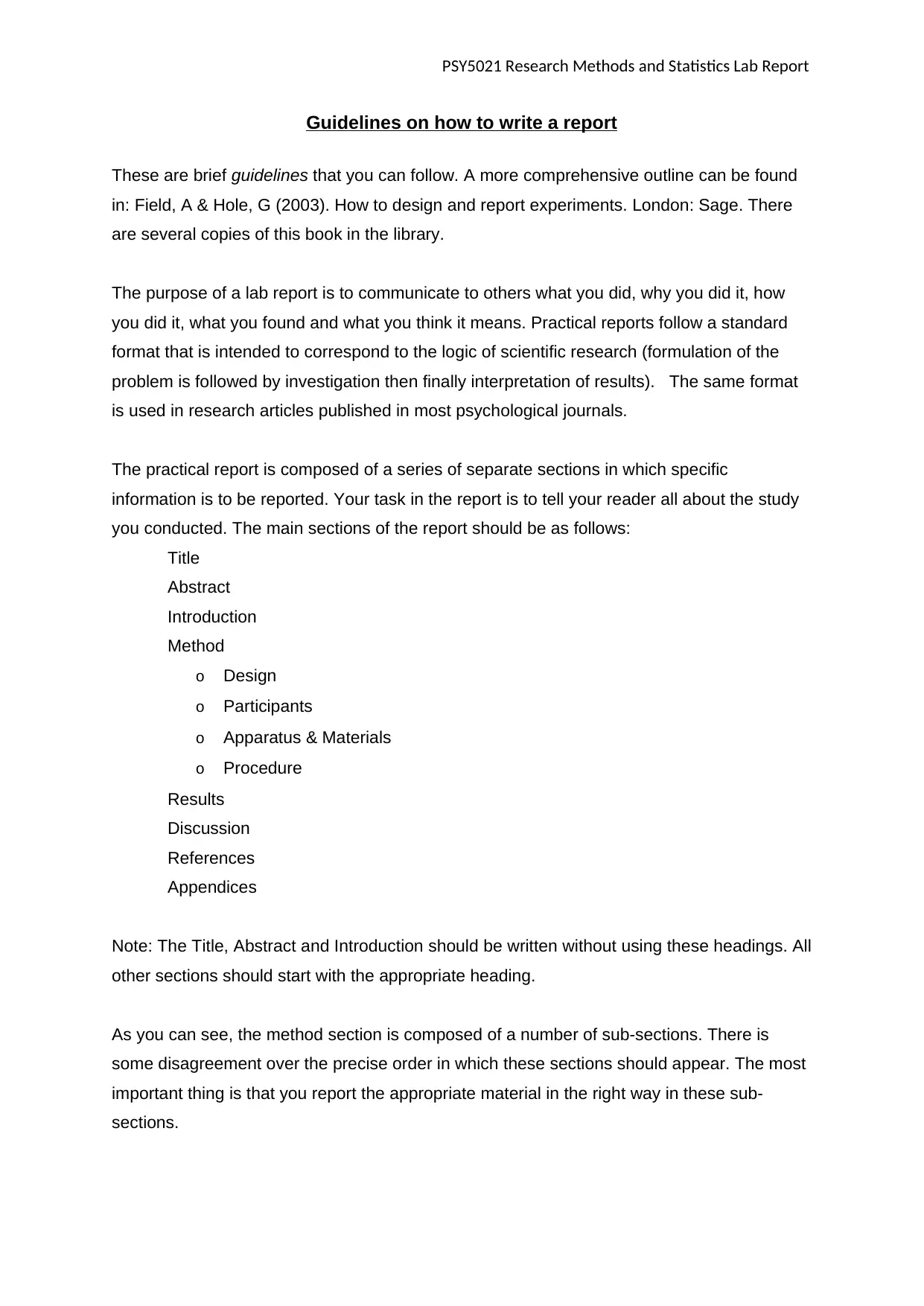
PSY5021 Research Methods and Statistics Lab Report
Guidelines on how to write a report
These are brief guidelines that you can follow. A more comprehensive outline can be found
in: Field, A & Hole, G (2003). How to design and report experiments. London: Sage. There
are several copies of this book in the library.
The purpose of a lab report is to communicate to others what you did, why you did it, how
you did it, what you found and what you think it means. Practical reports follow a standard
format that is intended to correspond to the logic of scientific research (formulation of the
problem is followed by investigation then finally interpretation of results). The same format
is used in research articles published in most psychological journals.
The practical report is composed of a series of separate sections in which specific
information is to be reported. Your task in the report is to tell your reader all about the study
you conducted. The main sections of the report should be as follows:
Title
Abstract
Introduction
Method
o Design
o Participants
o Apparatus & Materials
o Procedure
Results
Discussion
References
Appendices
Note: The Title, Abstract and Introduction should be written without using these headings. All
other sections should start with the appropriate heading.
As you can see, the method section is composed of a number of sub-sections. There is
some disagreement over the precise order in which these sections should appear. The most
important thing is that you report the appropriate material in the right way in these sub-
sections.
Guidelines on how to write a report
These are brief guidelines that you can follow. A more comprehensive outline can be found
in: Field, A & Hole, G (2003). How to design and report experiments. London: Sage. There
are several copies of this book in the library.
The purpose of a lab report is to communicate to others what you did, why you did it, how
you did it, what you found and what you think it means. Practical reports follow a standard
format that is intended to correspond to the logic of scientific research (formulation of the
problem is followed by investigation then finally interpretation of results). The same format
is used in research articles published in most psychological journals.
The practical report is composed of a series of separate sections in which specific
information is to be reported. Your task in the report is to tell your reader all about the study
you conducted. The main sections of the report should be as follows:
Title
Abstract
Introduction
Method
o Design
o Participants
o Apparatus & Materials
o Procedure
Results
Discussion
References
Appendices
Note: The Title, Abstract and Introduction should be written without using these headings. All
other sections should start with the appropriate heading.
As you can see, the method section is composed of a number of sub-sections. There is
some disagreement over the precise order in which these sections should appear. The most
important thing is that you report the appropriate material in the right way in these sub-
sections.
Paraphrase This Document
Need a fresh take? Get an instant paraphrase of this document with our AI Paraphraser
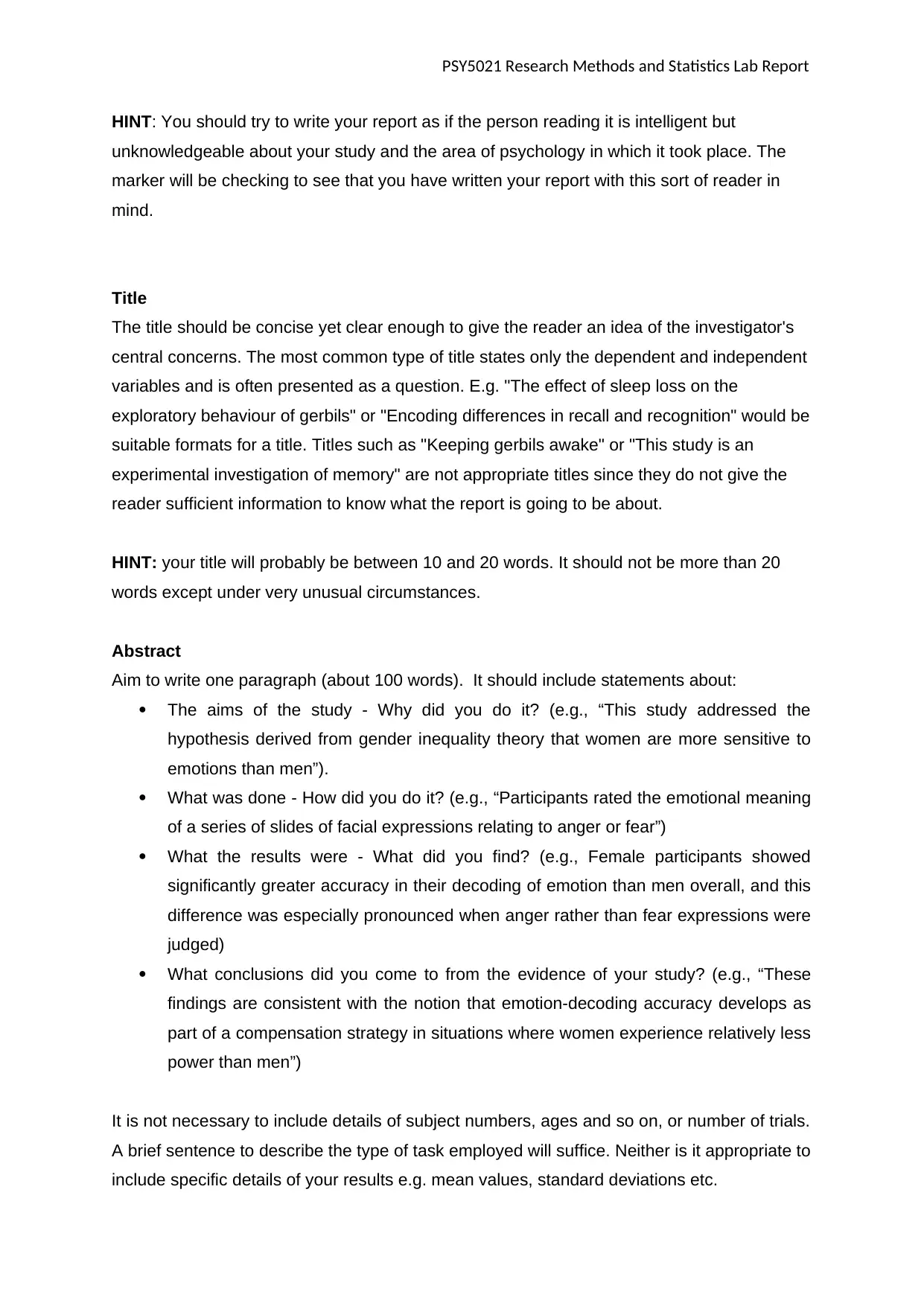
PSY5021 Research Methods and Statistics Lab Report
HINT: You should try to write your report as if the person reading it is intelligent but
unknowledgeable about your study and the area of psychology in which it took place. The
marker will be checking to see that you have written your report with this sort of reader in
mind.
Title
The title should be concise yet clear enough to give the reader an idea of the investigator's
central concerns. The most common type of title states only the dependent and independent
variables and is often presented as a question. E.g. "The effect of sleep loss on the
exploratory behaviour of gerbils" or "Encoding differences in recall and recognition" would be
suitable formats for a title. Titles such as "Keeping gerbils awake" or "This study is an
experimental investigation of memory" are not appropriate titles since they do not give the
reader sufficient information to know what the report is going to be about.
HINT: your title will probably be between 10 and 20 words. It should not be more than 20
words except under very unusual circumstances.
Abstract
Aim to write one paragraph (about 100 words). It should include statements about:
The aims of the study - Why did you do it? (e.g., “This study addressed the
hypothesis derived from gender inequality theory that women are more sensitive to
emotions than men”).
What was done - How did you do it? (e.g., “Participants rated the emotional meaning
of a series of slides of facial expressions relating to anger or fear”)
What the results were - What did you find? (e.g., Female participants showed
significantly greater accuracy in their decoding of emotion than men overall, and this
difference was especially pronounced when anger rather than fear expressions were
judged)
What conclusions did you come to from the evidence of your study? (e.g., “These
findings are consistent with the notion that emotion-decoding accuracy develops as
part of a compensation strategy in situations where women experience relatively less
power than men”)
It is not necessary to include details of subject numbers, ages and so on, or number of trials.
A brief sentence to describe the type of task employed will suffice. Neither is it appropriate to
include specific details of your results e.g. mean values, standard deviations etc.
HINT: You should try to write your report as if the person reading it is intelligent but
unknowledgeable about your study and the area of psychology in which it took place. The
marker will be checking to see that you have written your report with this sort of reader in
mind.
Title
The title should be concise yet clear enough to give the reader an idea of the investigator's
central concerns. The most common type of title states only the dependent and independent
variables and is often presented as a question. E.g. "The effect of sleep loss on the
exploratory behaviour of gerbils" or "Encoding differences in recall and recognition" would be
suitable formats for a title. Titles such as "Keeping gerbils awake" or "This study is an
experimental investigation of memory" are not appropriate titles since they do not give the
reader sufficient information to know what the report is going to be about.
HINT: your title will probably be between 10 and 20 words. It should not be more than 20
words except under very unusual circumstances.
Abstract
Aim to write one paragraph (about 100 words). It should include statements about:
The aims of the study - Why did you do it? (e.g., “This study addressed the
hypothesis derived from gender inequality theory that women are more sensitive to
emotions than men”).
What was done - How did you do it? (e.g., “Participants rated the emotional meaning
of a series of slides of facial expressions relating to anger or fear”)
What the results were - What did you find? (e.g., Female participants showed
significantly greater accuracy in their decoding of emotion than men overall, and this
difference was especially pronounced when anger rather than fear expressions were
judged)
What conclusions did you come to from the evidence of your study? (e.g., “These
findings are consistent with the notion that emotion-decoding accuracy develops as
part of a compensation strategy in situations where women experience relatively less
power than men”)
It is not necessary to include details of subject numbers, ages and so on, or number of trials.
A brief sentence to describe the type of task employed will suffice. Neither is it appropriate to
include specific details of your results e.g. mean values, standard deviations etc.
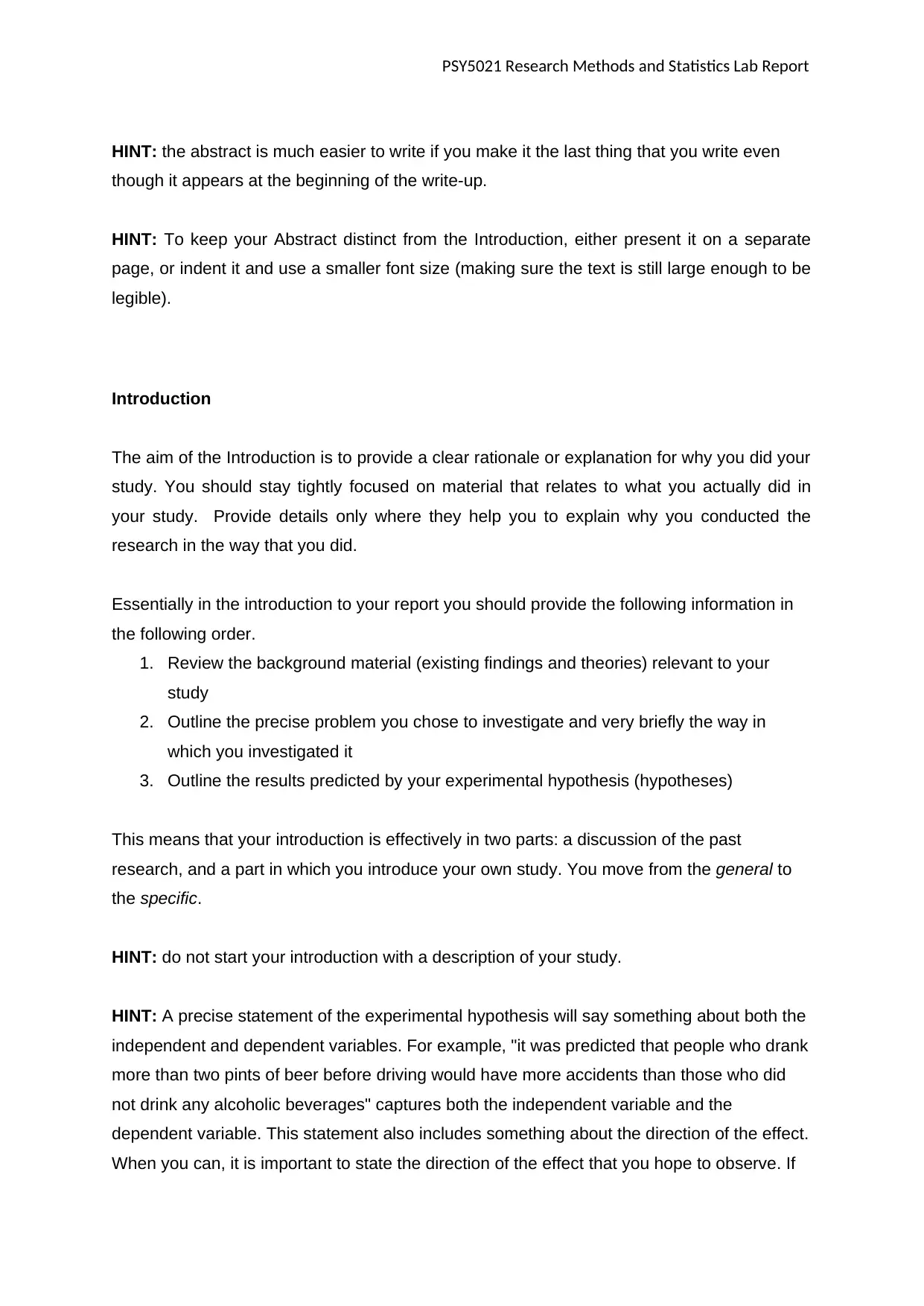
PSY5021 Research Methods and Statistics Lab Report
HINT: the abstract is much easier to write if you make it the last thing that you write even
though it appears at the beginning of the write-up.
HINT: To keep your Abstract distinct from the Introduction, either present it on a separate
page, or indent it and use a smaller font size (making sure the text is still large enough to be
legible).
Introduction
The aim of the Introduction is to provide a clear rationale or explanation for why you did your
study. You should stay tightly focused on material that relates to what you actually did in
your study. Provide details only where they help you to explain why you conducted the
research in the way that you did.
Essentially in the introduction to your report you should provide the following information in
the following order.
1. Review the background material (existing findings and theories) relevant to your
study
2. Outline the precise problem you chose to investigate and very briefly the way in
which you investigated it
3. Outline the results predicted by your experimental hypothesis (hypotheses)
This means that your introduction is effectively in two parts: a discussion of the past
research, and a part in which you introduce your own study. You move from the general to
the specific.
HINT: do not start your introduction with a description of your study.
HINT: A precise statement of the experimental hypothesis will say something about both the
independent and dependent variables. For example, "it was predicted that people who drank
more than two pints of beer before driving would have more accidents than those who did
not drink any alcoholic beverages" captures both the independent variable and the
dependent variable. This statement also includes something about the direction of the effect.
When you can, it is important to state the direction of the effect that you hope to observe. If
HINT: the abstract is much easier to write if you make it the last thing that you write even
though it appears at the beginning of the write-up.
HINT: To keep your Abstract distinct from the Introduction, either present it on a separate
page, or indent it and use a smaller font size (making sure the text is still large enough to be
legible).
Introduction
The aim of the Introduction is to provide a clear rationale or explanation for why you did your
study. You should stay tightly focused on material that relates to what you actually did in
your study. Provide details only where they help you to explain why you conducted the
research in the way that you did.
Essentially in the introduction to your report you should provide the following information in
the following order.
1. Review the background material (existing findings and theories) relevant to your
study
2. Outline the precise problem you chose to investigate and very briefly the way in
which you investigated it
3. Outline the results predicted by your experimental hypothesis (hypotheses)
This means that your introduction is effectively in two parts: a discussion of the past
research, and a part in which you introduce your own study. You move from the general to
the specific.
HINT: do not start your introduction with a description of your study.
HINT: A precise statement of the experimental hypothesis will say something about both the
independent and dependent variables. For example, "it was predicted that people who drank
more than two pints of beer before driving would have more accidents than those who did
not drink any alcoholic beverages" captures both the independent variable and the
dependent variable. This statement also includes something about the direction of the effect.
When you can, it is important to state the direction of the effect that you hope to observe. If
⊘ This is a preview!⊘
Do you want full access?
Subscribe today to unlock all pages.

Trusted by 1+ million students worldwide
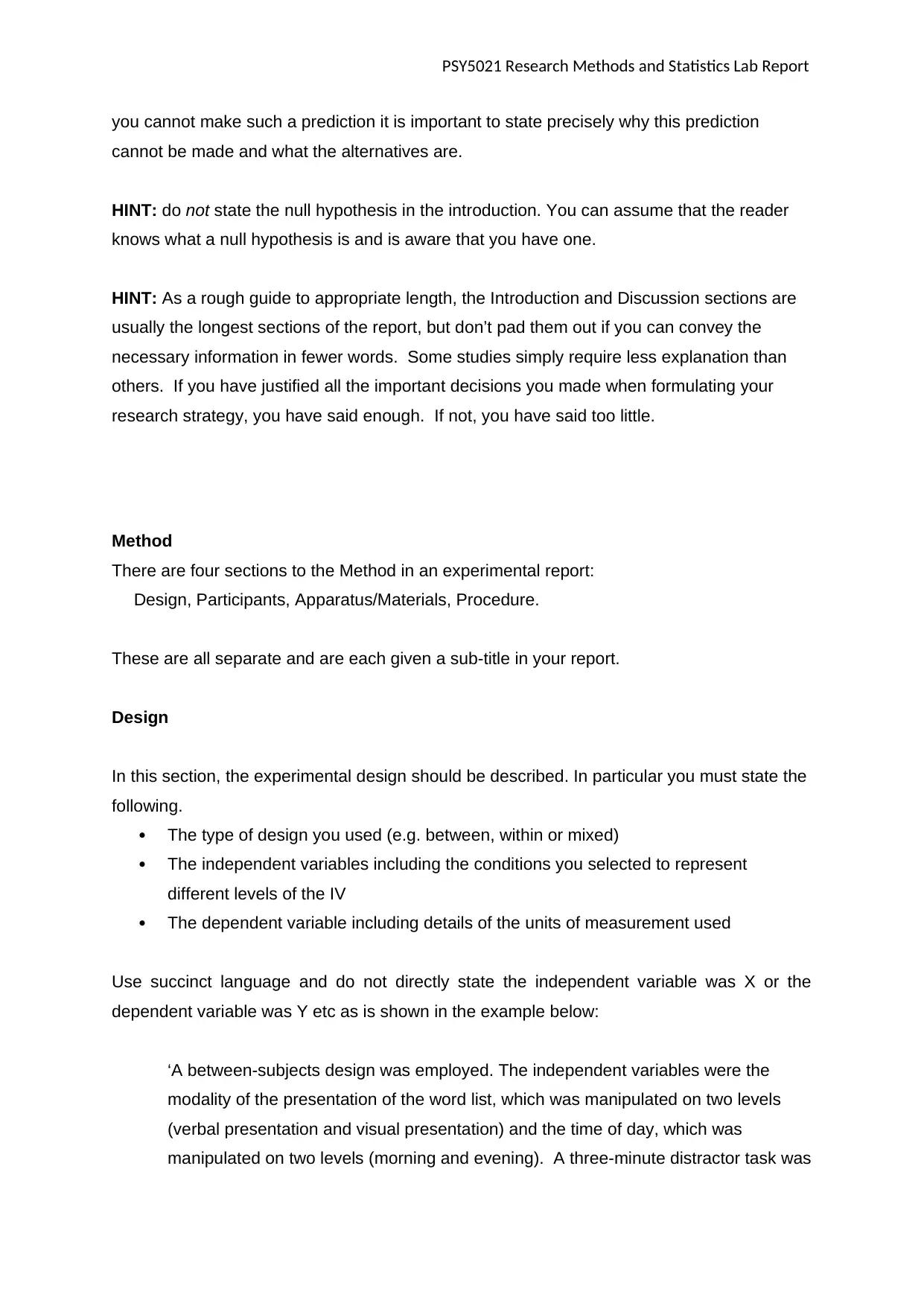
PSY5021 Research Methods and Statistics Lab Report
you cannot make such a prediction it is important to state precisely why this prediction
cannot be made and what the alternatives are.
HINT: do not state the null hypothesis in the introduction. You can assume that the reader
knows what a null hypothesis is and is aware that you have one.
HINT: As a rough guide to appropriate length, the Introduction and Discussion sections are
usually the longest sections of the report, but don’t pad them out if you can convey the
necessary information in fewer words. Some studies simply require less explanation than
others. If you have justified all the important decisions you made when formulating your
research strategy, you have said enough. If not, you have said too little.
Method
There are four sections to the Method in an experimental report:
Design, Participants, Apparatus/Materials, Procedure.
These are all separate and are each given a sub-title in your report.
Design
In this section, the experimental design should be described. In particular you must state the
following.
The type of design you used (e.g. between, within or mixed)
The independent variables including the conditions you selected to represent
different levels of the IV
The dependent variable including details of the units of measurement used
Use succinct language and do not directly state the independent variable was X or the
dependent variable was Y etc as is shown in the example below:
‘A between-subjects design was employed. The independent variables were the
modality of the presentation of the word list, which was manipulated on two levels
(verbal presentation and visual presentation) and the time of day, which was
manipulated on two levels (morning and evening). A three-minute distractor task was
you cannot make such a prediction it is important to state precisely why this prediction
cannot be made and what the alternatives are.
HINT: do not state the null hypothesis in the introduction. You can assume that the reader
knows what a null hypothesis is and is aware that you have one.
HINT: As a rough guide to appropriate length, the Introduction and Discussion sections are
usually the longest sections of the report, but don’t pad them out if you can convey the
necessary information in fewer words. Some studies simply require less explanation than
others. If you have justified all the important decisions you made when formulating your
research strategy, you have said enough. If not, you have said too little.
Method
There are four sections to the Method in an experimental report:
Design, Participants, Apparatus/Materials, Procedure.
These are all separate and are each given a sub-title in your report.
Design
In this section, the experimental design should be described. In particular you must state the
following.
The type of design you used (e.g. between, within or mixed)
The independent variables including the conditions you selected to represent
different levels of the IV
The dependent variable including details of the units of measurement used
Use succinct language and do not directly state the independent variable was X or the
dependent variable was Y etc as is shown in the example below:
‘A between-subjects design was employed. The independent variables were the
modality of the presentation of the word list, which was manipulated on two levels
(verbal presentation and visual presentation) and the time of day, which was
manipulated on two levels (morning and evening). A three-minute distractor task was
Paraphrase This Document
Need a fresh take? Get an instant paraphrase of this document with our AI Paraphraser
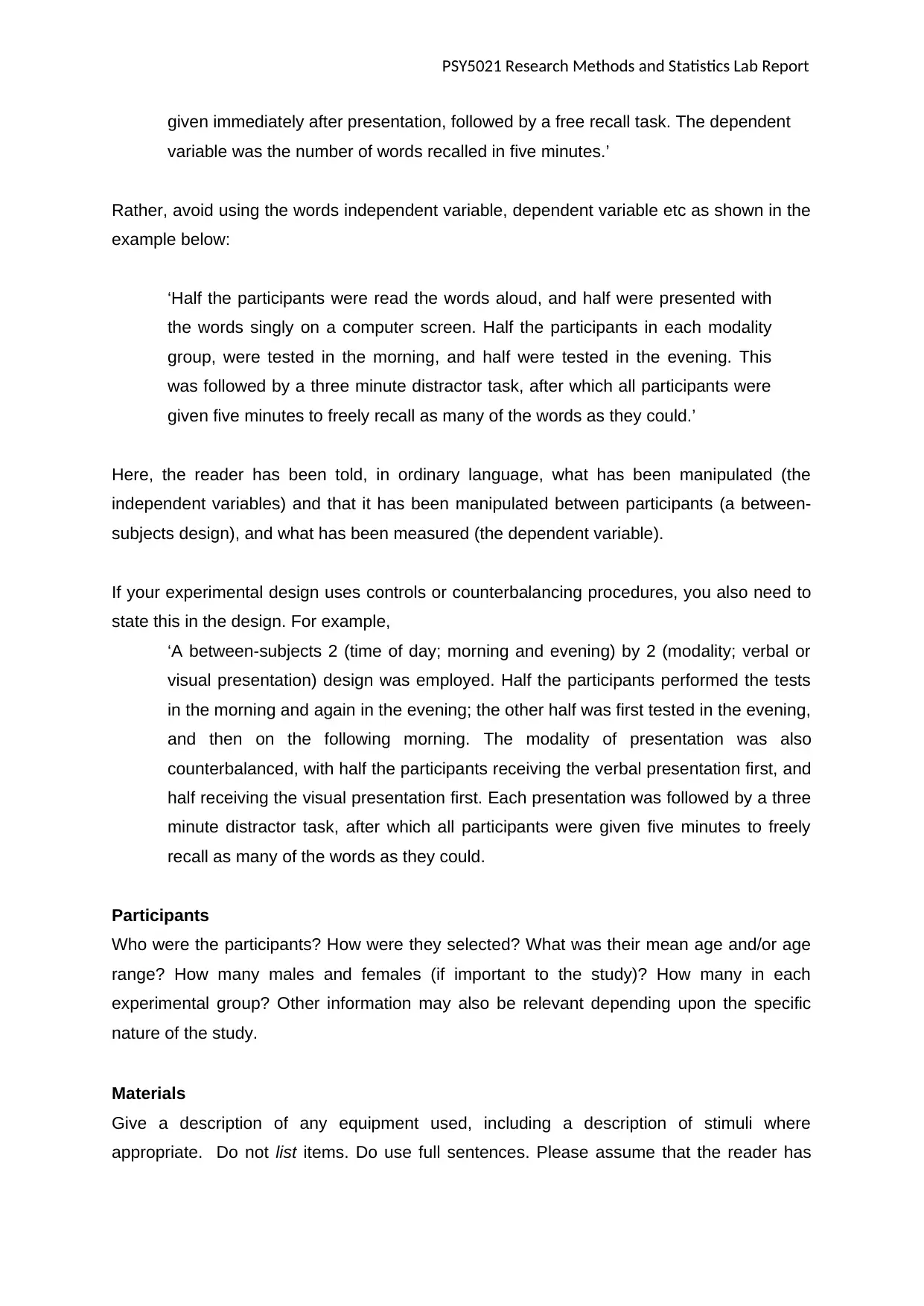
PSY5021 Research Methods and Statistics Lab Report
given immediately after presentation, followed by a free recall task. The dependent
variable was the number of words recalled in five minutes.’
Rather, avoid using the words independent variable, dependent variable etc as shown in the
example below:
‘Half the participants were read the words aloud, and half were presented with
the words singly on a computer screen. Half the participants in each modality
group, were tested in the morning, and half were tested in the evening. This
was followed by a three minute distractor task, after which all participants were
given five minutes to freely recall as many of the words as they could.’
Here, the reader has been told, in ordinary language, what has been manipulated (the
independent variables) and that it has been manipulated between participants (a between-
subjects design), and what has been measured (the dependent variable).
If your experimental design uses controls or counterbalancing procedures, you also need to
state this in the design. For example,
‘A between-subjects 2 (time of day; morning and evening) by 2 (modality; verbal or
visual presentation) design was employed. Half the participants performed the tests
in the morning and again in the evening; the other half was first tested in the evening,
and then on the following morning. The modality of presentation was also
counterbalanced, with half the participants receiving the verbal presentation first, and
half receiving the visual presentation first. Each presentation was followed by a three
minute distractor task, after which all participants were given five minutes to freely
recall as many of the words as they could.
Participants
Who were the participants? How were they selected? What was their mean age and/or age
range? How many males and females (if important to the study)? How many in each
experimental group? Other information may also be relevant depending upon the specific
nature of the study.
Materials
Give a description of any equipment used, including a description of stimuli where
appropriate. Do not list items. Do use full sentences. Please assume that the reader has
given immediately after presentation, followed by a free recall task. The dependent
variable was the number of words recalled in five minutes.’
Rather, avoid using the words independent variable, dependent variable etc as shown in the
example below:
‘Half the participants were read the words aloud, and half were presented with
the words singly on a computer screen. Half the participants in each modality
group, were tested in the morning, and half were tested in the evening. This
was followed by a three minute distractor task, after which all participants were
given five minutes to freely recall as many of the words as they could.’
Here, the reader has been told, in ordinary language, what has been manipulated (the
independent variables) and that it has been manipulated between participants (a between-
subjects design), and what has been measured (the dependent variable).
If your experimental design uses controls or counterbalancing procedures, you also need to
state this in the design. For example,
‘A between-subjects 2 (time of day; morning and evening) by 2 (modality; verbal or
visual presentation) design was employed. Half the participants performed the tests
in the morning and again in the evening; the other half was first tested in the evening,
and then on the following morning. The modality of presentation was also
counterbalanced, with half the participants receiving the verbal presentation first, and
half receiving the visual presentation first. Each presentation was followed by a three
minute distractor task, after which all participants were given five minutes to freely
recall as many of the words as they could.
Participants
Who were the participants? How were they selected? What was their mean age and/or age
range? How many males and females (if important to the study)? How many in each
experimental group? Other information may also be relevant depending upon the specific
nature of the study.
Materials
Give a description of any equipment used, including a description of stimuli where
appropriate. Do not list items. Do use full sentences. Please assume that the reader has
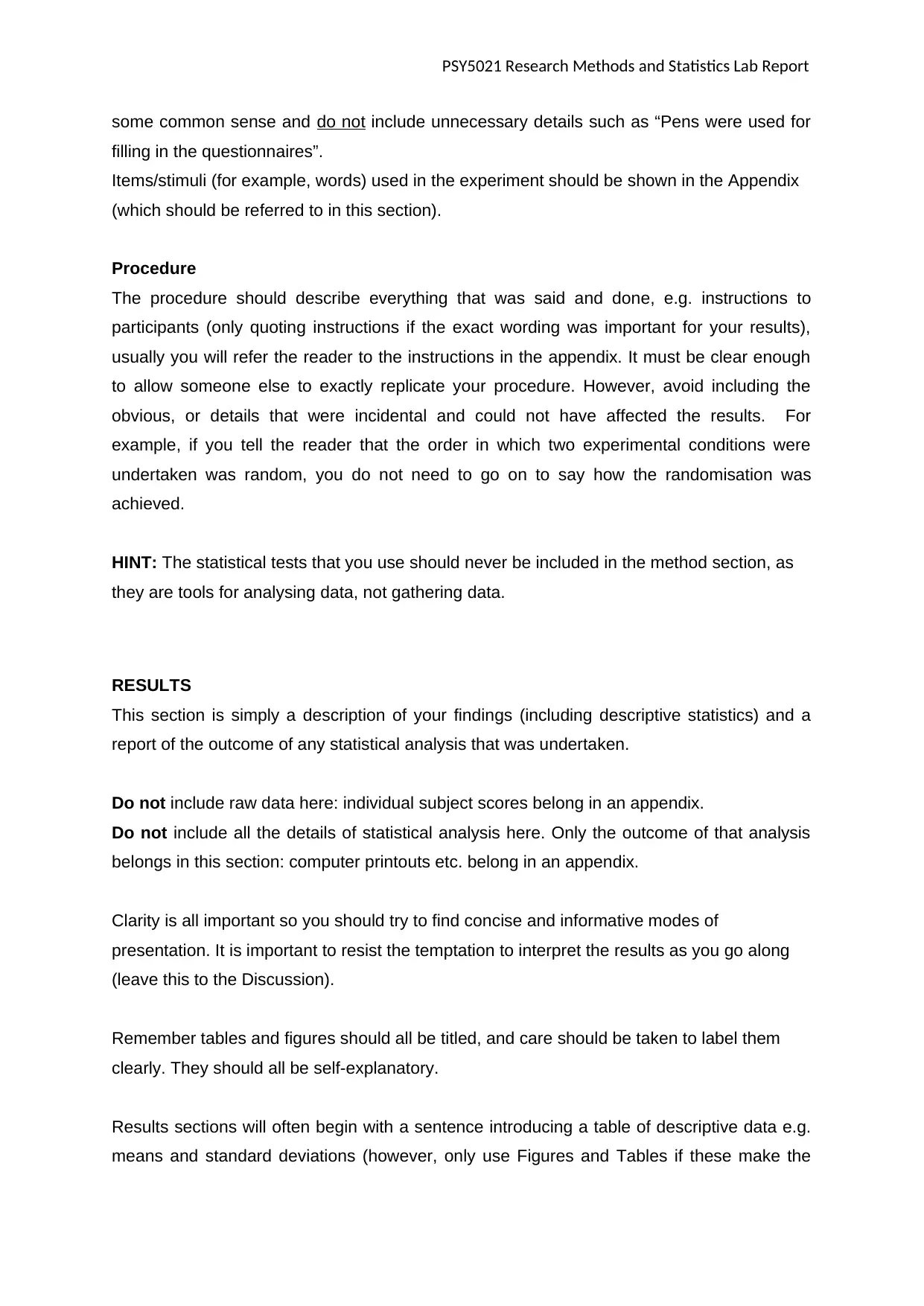
PSY5021 Research Methods and Statistics Lab Report
some common sense and do not include unnecessary details such as “Pens were used for
filling in the questionnaires”.
Items/stimuli (for example, words) used in the experiment should be shown in the Appendix
(which should be referred to in this section).
Procedure
The procedure should describe everything that was said and done, e.g. instructions to
participants (only quoting instructions if the exact wording was important for your results),
usually you will refer the reader to the instructions in the appendix. It must be clear enough
to allow someone else to exactly replicate your procedure. However, avoid including the
obvious, or details that were incidental and could not have affected the results. For
example, if you tell the reader that the order in which two experimental conditions were
undertaken was random, you do not need to go on to say how the randomisation was
achieved.
HINT: The statistical tests that you use should never be included in the method section, as
they are tools for analysing data, not gathering data.
RESULTS
This section is simply a description of your findings (including descriptive statistics) and a
report of the outcome of any statistical analysis that was undertaken.
Do not include raw data here: individual subject scores belong in an appendix.
Do not include all the details of statistical analysis here. Only the outcome of that analysis
belongs in this section: computer printouts etc. belong in an appendix.
Clarity is all important so you should try to find concise and informative modes of
presentation. It is important to resist the temptation to interpret the results as you go along
(leave this to the Discussion).
Remember tables and figures should all be titled, and care should be taken to label them
clearly. They should all be self-explanatory.
Results sections will often begin with a sentence introducing a table of descriptive data e.g.
means and standard deviations (however, only use Figures and Tables if these make the
some common sense and do not include unnecessary details such as “Pens were used for
filling in the questionnaires”.
Items/stimuli (for example, words) used in the experiment should be shown in the Appendix
(which should be referred to in this section).
Procedure
The procedure should describe everything that was said and done, e.g. instructions to
participants (only quoting instructions if the exact wording was important for your results),
usually you will refer the reader to the instructions in the appendix. It must be clear enough
to allow someone else to exactly replicate your procedure. However, avoid including the
obvious, or details that were incidental and could not have affected the results. For
example, if you tell the reader that the order in which two experimental conditions were
undertaken was random, you do not need to go on to say how the randomisation was
achieved.
HINT: The statistical tests that you use should never be included in the method section, as
they are tools for analysing data, not gathering data.
RESULTS
This section is simply a description of your findings (including descriptive statistics) and a
report of the outcome of any statistical analysis that was undertaken.
Do not include raw data here: individual subject scores belong in an appendix.
Do not include all the details of statistical analysis here. Only the outcome of that analysis
belongs in this section: computer printouts etc. belong in an appendix.
Clarity is all important so you should try to find concise and informative modes of
presentation. It is important to resist the temptation to interpret the results as you go along
(leave this to the Discussion).
Remember tables and figures should all be titled, and care should be taken to label them
clearly. They should all be self-explanatory.
Results sections will often begin with a sentence introducing a table of descriptive data e.g.
means and standard deviations (however, only use Figures and Tables if these make the
⊘ This is a preview!⊘
Do you want full access?
Subscribe today to unlock all pages.

Trusted by 1+ million students worldwide
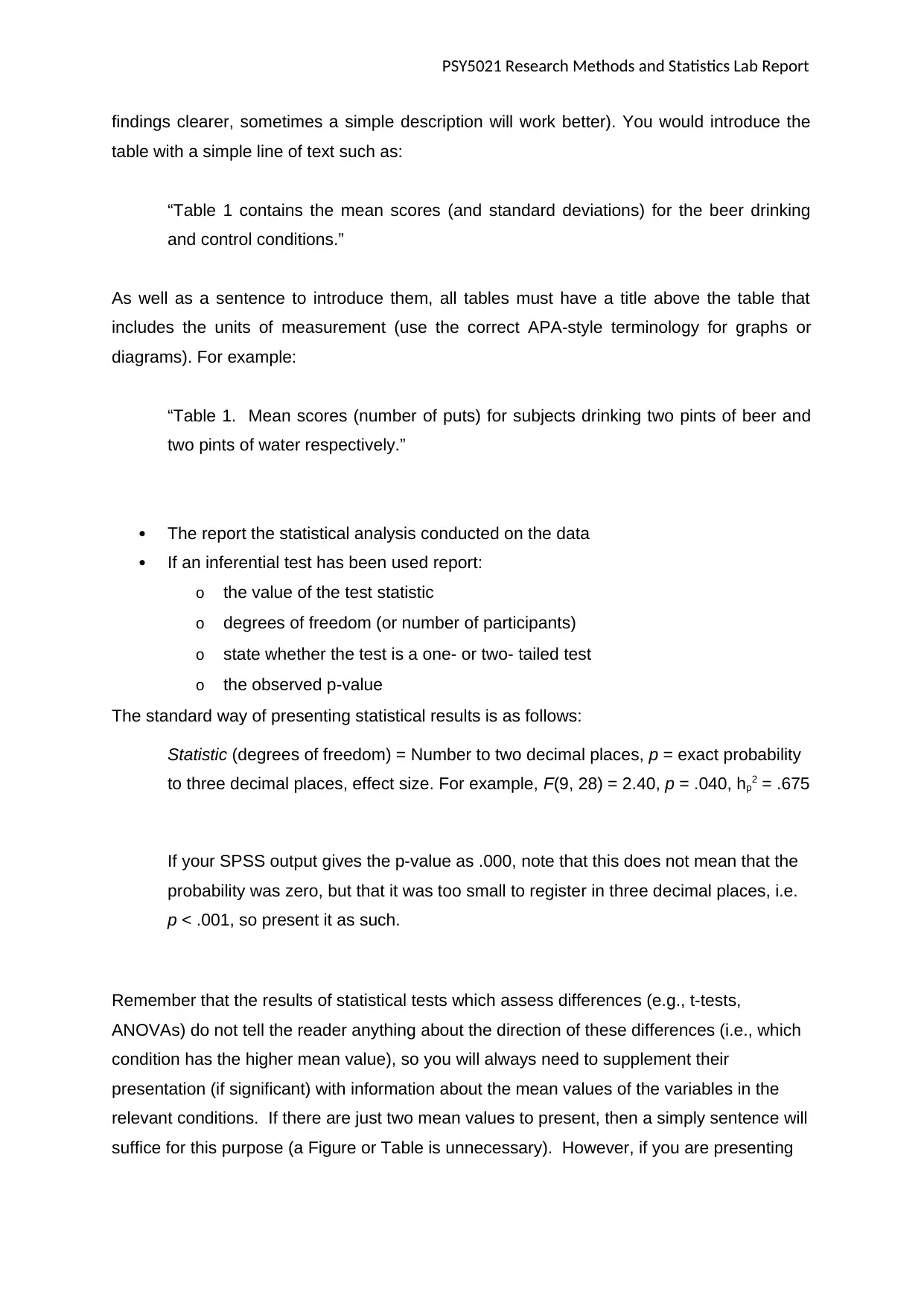
PSY5021 Research Methods and Statistics Lab Report
findings clearer, sometimes a simple description will work better). You would introduce the
table with a simple line of text such as:
“Table 1 contains the mean scores (and standard deviations) for the beer drinking
and control conditions.”
As well as a sentence to introduce them, all tables must have a title above the table that
includes the units of measurement (use the correct APA-style terminology for graphs or
diagrams). For example:
“Table 1. Mean scores (number of puts) for subjects drinking two pints of beer and
two pints of water respectively.”
The report the statistical analysis conducted on the data
If an inferential test has been used report:
o the value of the test statistic
o degrees of freedom (or number of participants)
o state whether the test is a one- or two- tailed test
o the observed p-value
The standard way of presenting statistical results is as follows:
Statistic (degrees of freedom) = Number to two decimal places, p = exact probability
to three decimal places, effect size. For example, F(9, 28) = 2.40, p = .040, hp2 = .675
If your SPSS output gives the p-value as .000, note that this does not mean that the
probability was zero, but that it was too small to register in three decimal places, i.e.
p < .001, so present it as such.
Remember that the results of statistical tests which assess differences (e.g., t-tests,
ANOVAs) do not tell the reader anything about the direction of these differences (i.e., which
condition has the higher mean value), so you will always need to supplement their
presentation (if significant) with information about the mean values of the variables in the
relevant conditions. If there are just two mean values to present, then a simply sentence will
suffice for this purpose (a Figure or Table is unnecessary). However, if you are presenting
findings clearer, sometimes a simple description will work better). You would introduce the
table with a simple line of text such as:
“Table 1 contains the mean scores (and standard deviations) for the beer drinking
and control conditions.”
As well as a sentence to introduce them, all tables must have a title above the table that
includes the units of measurement (use the correct APA-style terminology for graphs or
diagrams). For example:
“Table 1. Mean scores (number of puts) for subjects drinking two pints of beer and
two pints of water respectively.”
The report the statistical analysis conducted on the data
If an inferential test has been used report:
o the value of the test statistic
o degrees of freedom (or number of participants)
o state whether the test is a one- or two- tailed test
o the observed p-value
The standard way of presenting statistical results is as follows:
Statistic (degrees of freedom) = Number to two decimal places, p = exact probability
to three decimal places, effect size. For example, F(9, 28) = 2.40, p = .040, hp2 = .675
If your SPSS output gives the p-value as .000, note that this does not mean that the
probability was zero, but that it was too small to register in three decimal places, i.e.
p < .001, so present it as such.
Remember that the results of statistical tests which assess differences (e.g., t-tests,
ANOVAs) do not tell the reader anything about the direction of these differences (i.e., which
condition has the higher mean value), so you will always need to supplement their
presentation (if significant) with information about the mean values of the variables in the
relevant conditions. If there are just two mean values to present, then a simply sentence will
suffice for this purpose (a Figure or Table is unnecessary). However, if you are presenting
Paraphrase This Document
Need a fresh take? Get an instant paraphrase of this document with our AI Paraphraser
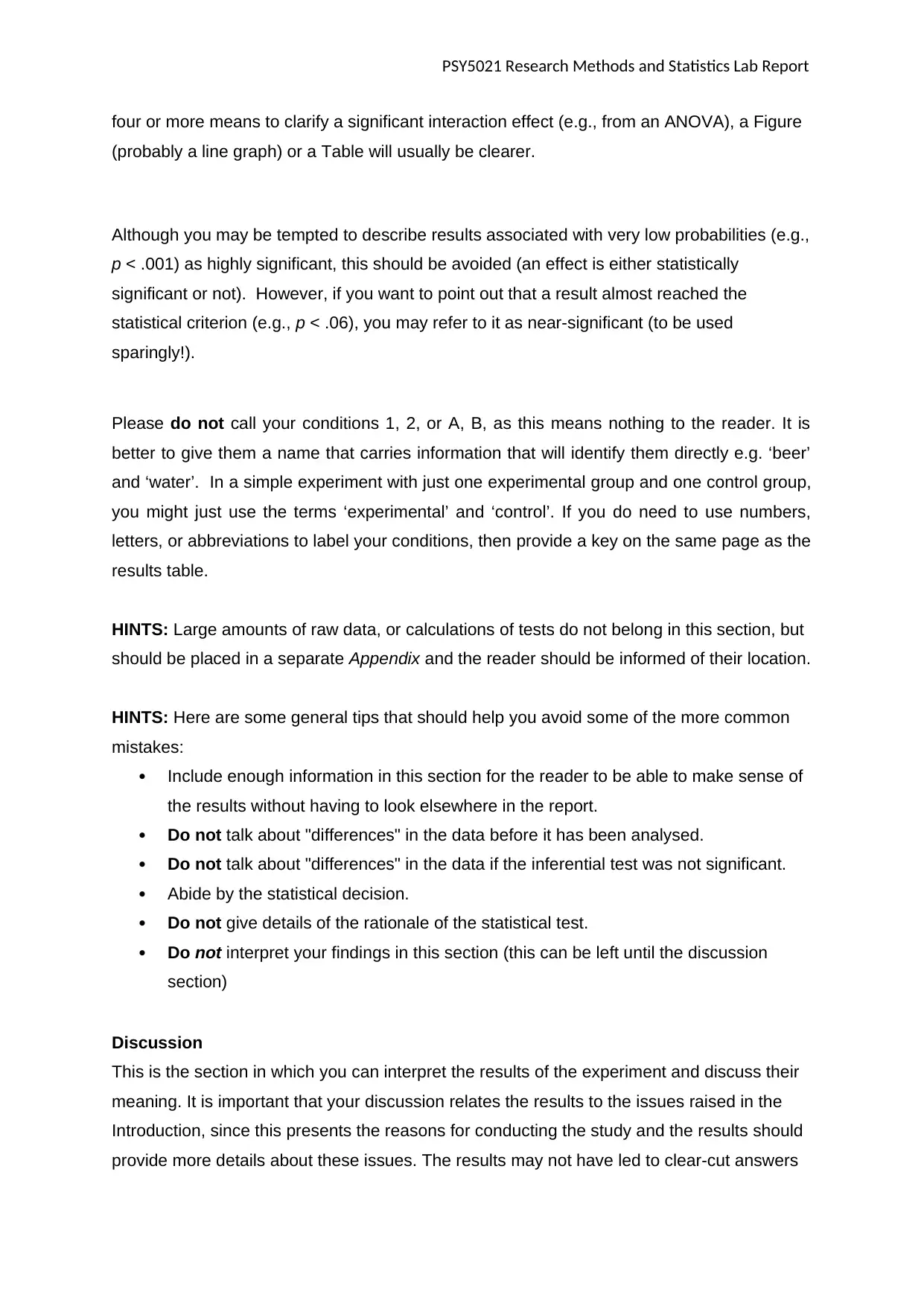
PSY5021 Research Methods and Statistics Lab Report
four or more means to clarify a significant interaction effect (e.g., from an ANOVA), a Figure
(probably a line graph) or a Table will usually be clearer.
Although you may be tempted to describe results associated with very low probabilities (e.g.,
p < .001) as highly significant, this should be avoided (an effect is either statistically
significant or not). However, if you want to point out that a result almost reached the
statistical criterion (e.g., p < .06), you may refer to it as near-significant (to be used
sparingly!).
Please do not call your conditions 1, 2, or A, B, as this means nothing to the reader. It is
better to give them a name that carries information that will identify them directly e.g. ‘beer’
and ‘water’. In a simple experiment with just one experimental group and one control group,
you might just use the terms ‘experimental’ and ‘control’. If you do need to use numbers,
letters, or abbreviations to label your conditions, then provide a key on the same page as the
results table.
HINTS: Large amounts of raw data, or calculations of tests do not belong in this section, but
should be placed in a separate Appendix and the reader should be informed of their location.
HINTS: Here are some general tips that should help you avoid some of the more common
mistakes:
Include enough information in this section for the reader to be able to make sense of
the results without having to look elsewhere in the report.
Do not talk about "differences" in the data before it has been analysed.
Do not talk about "differences" in the data if the inferential test was not significant.
Abide by the statistical decision.
Do not give details of the rationale of the statistical test.
Do not interpret your findings in this section (this can be left until the discussion
section)
Discussion
This is the section in which you can interpret the results of the experiment and discuss their
meaning. It is important that your discussion relates the results to the issues raised in the
Introduction, since this presents the reasons for conducting the study and the results should
provide more details about these issues. The results may not have led to clear-cut answers
four or more means to clarify a significant interaction effect (e.g., from an ANOVA), a Figure
(probably a line graph) or a Table will usually be clearer.
Although you may be tempted to describe results associated with very low probabilities (e.g.,
p < .001) as highly significant, this should be avoided (an effect is either statistically
significant or not). However, if you want to point out that a result almost reached the
statistical criterion (e.g., p < .06), you may refer to it as near-significant (to be used
sparingly!).
Please do not call your conditions 1, 2, or A, B, as this means nothing to the reader. It is
better to give them a name that carries information that will identify them directly e.g. ‘beer’
and ‘water’. In a simple experiment with just one experimental group and one control group,
you might just use the terms ‘experimental’ and ‘control’. If you do need to use numbers,
letters, or abbreviations to label your conditions, then provide a key on the same page as the
results table.
HINTS: Large amounts of raw data, or calculations of tests do not belong in this section, but
should be placed in a separate Appendix and the reader should be informed of their location.
HINTS: Here are some general tips that should help you avoid some of the more common
mistakes:
Include enough information in this section for the reader to be able to make sense of
the results without having to look elsewhere in the report.
Do not talk about "differences" in the data before it has been analysed.
Do not talk about "differences" in the data if the inferential test was not significant.
Abide by the statistical decision.
Do not give details of the rationale of the statistical test.
Do not interpret your findings in this section (this can be left until the discussion
section)
Discussion
This is the section in which you can interpret the results of the experiment and discuss their
meaning. It is important that your discussion relates the results to the issues raised in the
Introduction, since this presents the reasons for conducting the study and the results should
provide more details about these issues. The results may not have led to clear-cut answers
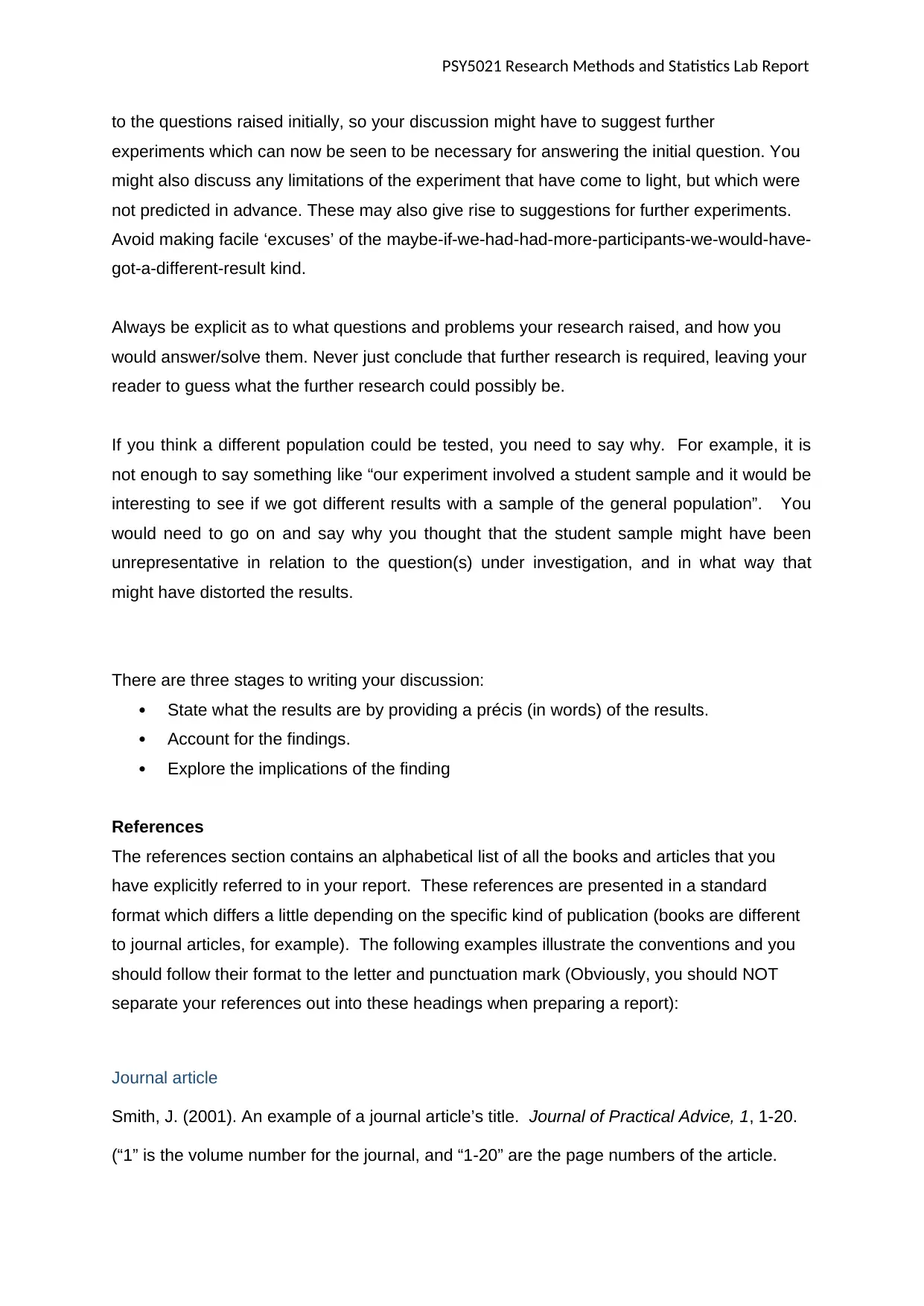
PSY5021 Research Methods and Statistics Lab Report
to the questions raised initially, so your discussion might have to suggest further
experiments which can now be seen to be necessary for answering the initial question. You
might also discuss any limitations of the experiment that have come to light, but which were
not predicted in advance. These may also give rise to suggestions for further experiments.
Avoid making facile ‘excuses’ of the maybe-if-we-had-had-more-participants-we-would-have-
got-a-different-result kind.
Always be explicit as to what questions and problems your research raised, and how you
would answer/solve them. Never just conclude that further research is required, leaving your
reader to guess what the further research could possibly be.
If you think a different population could be tested, you need to say why. For example, it is
not enough to say something like “our experiment involved a student sample and it would be
interesting to see if we got different results with a sample of the general population”. You
would need to go on and say why you thought that the student sample might have been
unrepresentative in relation to the question(s) under investigation, and in what way that
might have distorted the results.
There are three stages to writing your discussion:
State what the results are by providing a précis (in words) of the results.
Account for the findings.
Explore the implications of the finding
References
The references section contains an alphabetical list of all the books and articles that you
have explicitly referred to in your report. These references are presented in a standard
format which differs a little depending on the specific kind of publication (books are different
to journal articles, for example). The following examples illustrate the conventions and you
should follow their format to the letter and punctuation mark (Obviously, you should NOT
separate your references out into these headings when preparing a report):
Journal article
Smith, J. (2001). An example of a journal article’s title. Journal of Practical Advice, 1, 1-20.
(“1” is the volume number for the journal, and “1-20” are the page numbers of the article.
to the questions raised initially, so your discussion might have to suggest further
experiments which can now be seen to be necessary for answering the initial question. You
might also discuss any limitations of the experiment that have come to light, but which were
not predicted in advance. These may also give rise to suggestions for further experiments.
Avoid making facile ‘excuses’ of the maybe-if-we-had-had-more-participants-we-would-have-
got-a-different-result kind.
Always be explicit as to what questions and problems your research raised, and how you
would answer/solve them. Never just conclude that further research is required, leaving your
reader to guess what the further research could possibly be.
If you think a different population could be tested, you need to say why. For example, it is
not enough to say something like “our experiment involved a student sample and it would be
interesting to see if we got different results with a sample of the general population”. You
would need to go on and say why you thought that the student sample might have been
unrepresentative in relation to the question(s) under investigation, and in what way that
might have distorted the results.
There are three stages to writing your discussion:
State what the results are by providing a précis (in words) of the results.
Account for the findings.
Explore the implications of the finding
References
The references section contains an alphabetical list of all the books and articles that you
have explicitly referred to in your report. These references are presented in a standard
format which differs a little depending on the specific kind of publication (books are different
to journal articles, for example). The following examples illustrate the conventions and you
should follow their format to the letter and punctuation mark (Obviously, you should NOT
separate your references out into these headings when preparing a report):
Journal article
Smith, J. (2001). An example of a journal article’s title. Journal of Practical Advice, 1, 1-20.
(“1” is the volume number for the journal, and “1-20” are the page numbers of the article.
⊘ This is a preview!⊘
Do you want full access?
Subscribe today to unlock all pages.

Trusted by 1+ million students worldwide
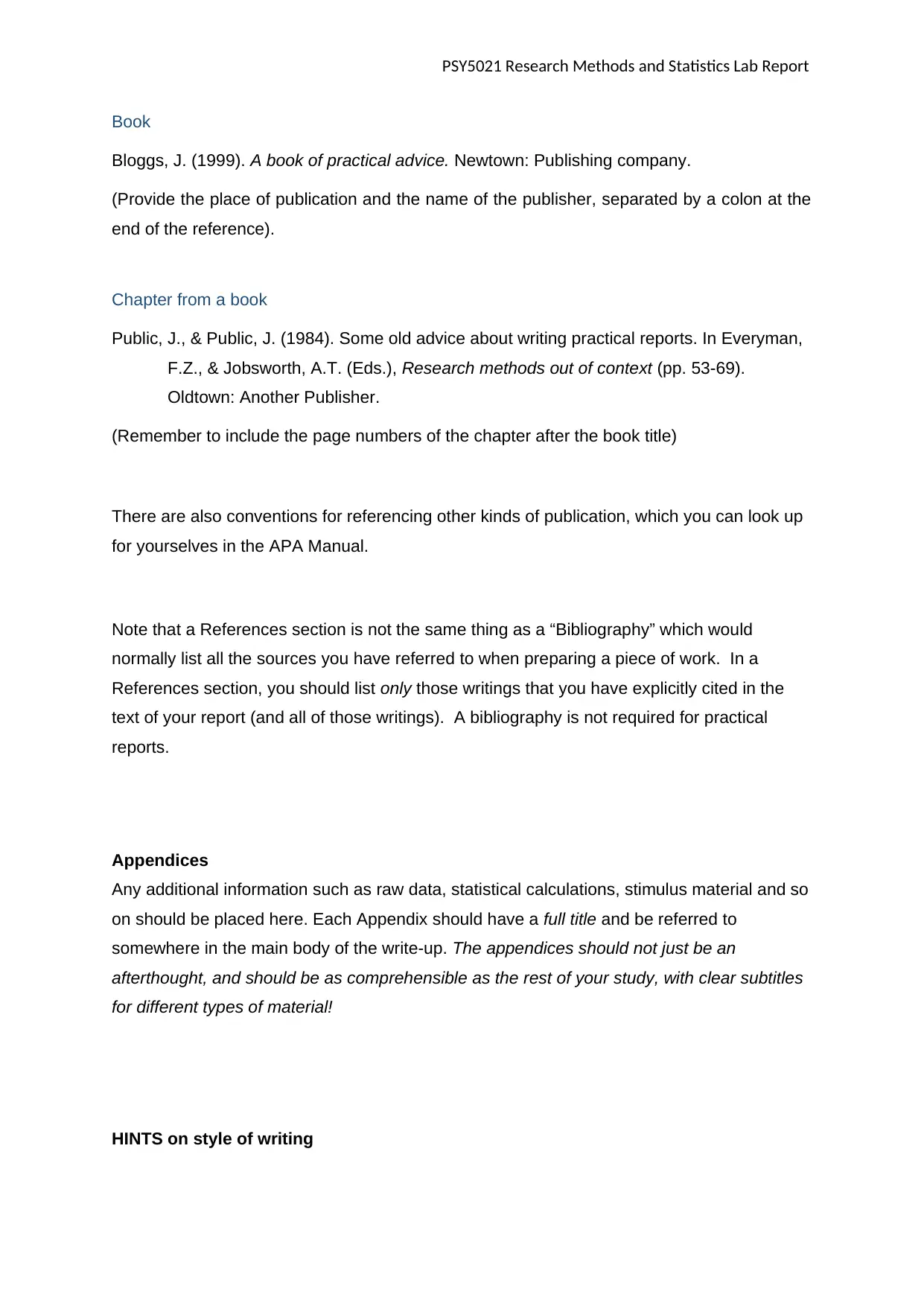
PSY5021 Research Methods and Statistics Lab Report
Book
Bloggs, J. (1999). A book of practical advice. Newtown: Publishing company.
(Provide the place of publication and the name of the publisher, separated by a colon at the
end of the reference).
Chapter from a book
Public, J., & Public, J. (1984). Some old advice about writing practical reports. In Everyman,
F.Z., & Jobsworth, A.T. (Eds.), Research methods out of context (pp. 53-69).
Oldtown: Another Publisher.
(Remember to include the page numbers of the chapter after the book title)
There are also conventions for referencing other kinds of publication, which you can look up
for yourselves in the APA Manual.
Note that a References section is not the same thing as a “Bibliography” which would
normally list all the sources you have referred to when preparing a piece of work. In a
References section, you should list only those writings that you have explicitly cited in the
text of your report (and all of those writings). A bibliography is not required for practical
reports.
Appendices
Any additional information such as raw data, statistical calculations, stimulus material and so
on should be placed here. Each Appendix should have a full title and be referred to
somewhere in the main body of the write-up. The appendices should not just be an
afterthought, and should be as comprehensible as the rest of your study, with clear subtitles
for different types of material!
Some notes on style
HINTS on style of writing
Book
Bloggs, J. (1999). A book of practical advice. Newtown: Publishing company.
(Provide the place of publication and the name of the publisher, separated by a colon at the
end of the reference).
Chapter from a book
Public, J., & Public, J. (1984). Some old advice about writing practical reports. In Everyman,
F.Z., & Jobsworth, A.T. (Eds.), Research methods out of context (pp. 53-69).
Oldtown: Another Publisher.
(Remember to include the page numbers of the chapter after the book title)
There are also conventions for referencing other kinds of publication, which you can look up
for yourselves in the APA Manual.
Note that a References section is not the same thing as a “Bibliography” which would
normally list all the sources you have referred to when preparing a piece of work. In a
References section, you should list only those writings that you have explicitly cited in the
text of your report (and all of those writings). A bibliography is not required for practical
reports.
Appendices
Any additional information such as raw data, statistical calculations, stimulus material and so
on should be placed here. Each Appendix should have a full title and be referred to
somewhere in the main body of the write-up. The appendices should not just be an
afterthought, and should be as comprehensible as the rest of your study, with clear subtitles
for different types of material!
Some notes on style
HINTS on style of writing
Paraphrase This Document
Need a fresh take? Get an instant paraphrase of this document with our AI Paraphraser
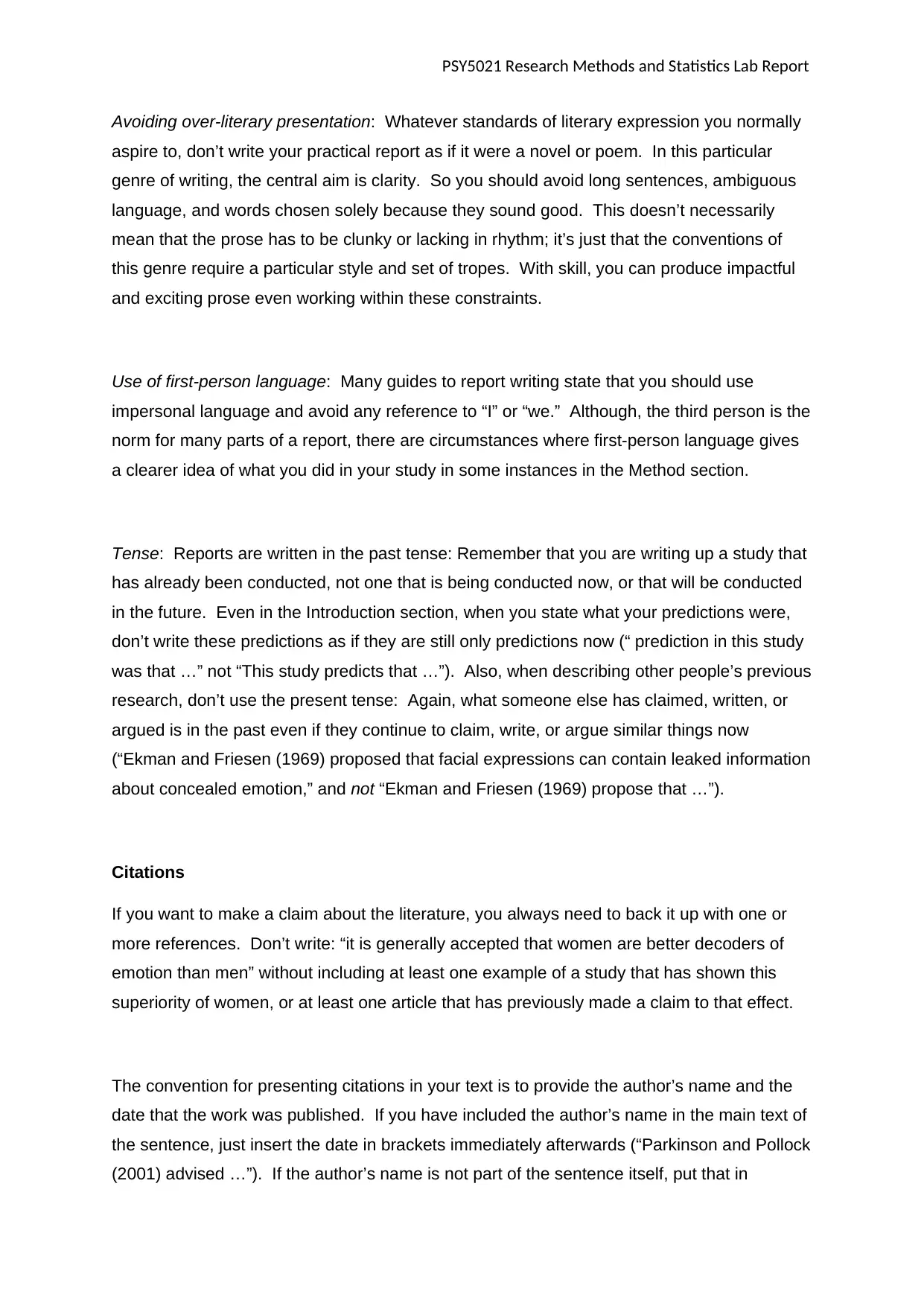
PSY5021 Research Methods and Statistics Lab Report
Avoiding over-literary presentation: Whatever standards of literary expression you normally
aspire to, don’t write your practical report as if it were a novel or poem. In this particular
genre of writing, the central aim is clarity. So you should avoid long sentences, ambiguous
language, and words chosen solely because they sound good. This doesn’t necessarily
mean that the prose has to be clunky or lacking in rhythm; it’s just that the conventions of
this genre require a particular style and set of tropes. With skill, you can produce impactful
and exciting prose even working within these constraints.
Use of first-person language: Many guides to report writing state that you should use
impersonal language and avoid any reference to “I” or “we.” Although, the third person is the
norm for many parts of a report, there are circumstances where first-person language gives
a clearer idea of what you did in your study in some instances in the Method section.
Tense: Reports are written in the past tense: Remember that you are writing up a study that
has already been conducted, not one that is being conducted now, or that will be conducted
in the future. Even in the Introduction section, when you state what your predictions were,
don’t write these predictions as if they are still only predictions now (“ prediction in this study
was that …” not “This study predicts that …”). Also, when describing other people’s previous
research, don’t use the present tense: Again, what someone else has claimed, written, or
argued is in the past even if they continue to claim, write, or argue similar things now
(“Ekman and Friesen (1969) proposed that facial expressions can contain leaked information
about concealed emotion,” and not “Ekman and Friesen (1969) propose that …”).
Citations
If you want to make a claim about the literature, you always need to back it up with one or
more references. Don’t write: “it is generally accepted that women are better decoders of
emotion than men” without including at least one example of a study that has shown this
superiority of women, or at least one article that has previously made a claim to that effect.
The convention for presenting citations in your text is to provide the author’s name and the
date that the work was published. If you have included the author’s name in the main text of
the sentence, just insert the date in brackets immediately afterwards (“Parkinson and Pollock
(2001) advised …”). If the author’s name is not part of the sentence itself, put that in
Avoiding over-literary presentation: Whatever standards of literary expression you normally
aspire to, don’t write your practical report as if it were a novel or poem. In this particular
genre of writing, the central aim is clarity. So you should avoid long sentences, ambiguous
language, and words chosen solely because they sound good. This doesn’t necessarily
mean that the prose has to be clunky or lacking in rhythm; it’s just that the conventions of
this genre require a particular style and set of tropes. With skill, you can produce impactful
and exciting prose even working within these constraints.
Use of first-person language: Many guides to report writing state that you should use
impersonal language and avoid any reference to “I” or “we.” Although, the third person is the
norm for many parts of a report, there are circumstances where first-person language gives
a clearer idea of what you did in your study in some instances in the Method section.
Tense: Reports are written in the past tense: Remember that you are writing up a study that
has already been conducted, not one that is being conducted now, or that will be conducted
in the future. Even in the Introduction section, when you state what your predictions were,
don’t write these predictions as if they are still only predictions now (“ prediction in this study
was that …” not “This study predicts that …”). Also, when describing other people’s previous
research, don’t use the present tense: Again, what someone else has claimed, written, or
argued is in the past even if they continue to claim, write, or argue similar things now
(“Ekman and Friesen (1969) proposed that facial expressions can contain leaked information
about concealed emotion,” and not “Ekman and Friesen (1969) propose that …”).
Citations
If you want to make a claim about the literature, you always need to back it up with one or
more references. Don’t write: “it is generally accepted that women are better decoders of
emotion than men” without including at least one example of a study that has shown this
superiority of women, or at least one article that has previously made a claim to that effect.
The convention for presenting citations in your text is to provide the author’s name and the
date that the work was published. If you have included the author’s name in the main text of
the sentence, just insert the date in brackets immediately afterwards (“Parkinson and Pollock
(2001) advised …”). If the author’s name is not part of the sentence itself, put that in
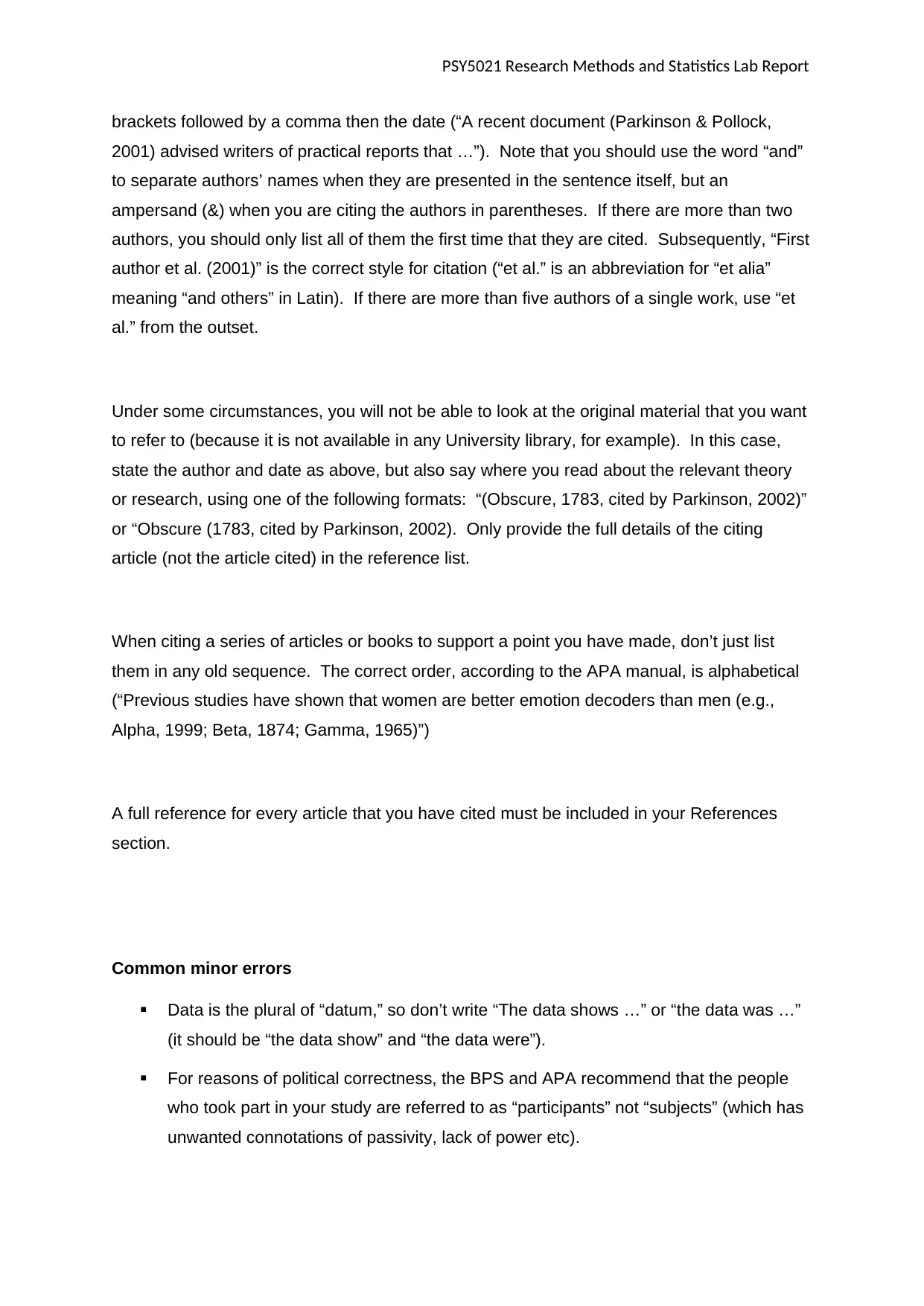
PSY5021 Research Methods and Statistics Lab Report
brackets followed by a comma then the date (“A recent document (Parkinson & Pollock,
2001) advised writers of practical reports that …”). Note that you should use the word “and”
to separate authors’ names when they are presented in the sentence itself, but an
ampersand (&) when you are citing the authors in parentheses. If there are more than two
authors, you should only list all of them the first time that they are cited. Subsequently, “First
author et al. (2001)” is the correct style for citation (“et al.” is an abbreviation for “et alia”
meaning “and others” in Latin). If there are more than five authors of a single work, use “et
al.” from the outset.
Under some circumstances, you will not be able to look at the original material that you want
to refer to (because it is not available in any University library, for example). In this case,
state the author and date as above, but also say where you read about the relevant theory
or research, using one of the following formats: “(Obscure, 1783, cited by Parkinson, 2002)”
or “Obscure (1783, cited by Parkinson, 2002). Only provide the full details of the citing
article (not the article cited) in the reference list.
When citing a series of articles or books to support a point you have made, don’t just list
them in any old sequence. The correct order, according to the APA manual, is alphabetical
(“Previous studies have shown that women are better emotion decoders than men (e.g.,
Alpha, 1999; Beta, 1874; Gamma, 1965)”)
A full reference for every article that you have cited must be included in your References
section.
Common minor errors
Data is the plural of “datum,” so don’t write “The data shows …” or “the data was …”
(it should be “the data show” and “the data were”).
For reasons of political correctness, the BPS and APA recommend that the people
who took part in your study are referred to as “participants” not “subjects” (which has
unwanted connotations of passivity, lack of power etc).
brackets followed by a comma then the date (“A recent document (Parkinson & Pollock,
2001) advised writers of practical reports that …”). Note that you should use the word “and”
to separate authors’ names when they are presented in the sentence itself, but an
ampersand (&) when you are citing the authors in parentheses. If there are more than two
authors, you should only list all of them the first time that they are cited. Subsequently, “First
author et al. (2001)” is the correct style for citation (“et al.” is an abbreviation for “et alia”
meaning “and others” in Latin). If there are more than five authors of a single work, use “et
al.” from the outset.
Under some circumstances, you will not be able to look at the original material that you want
to refer to (because it is not available in any University library, for example). In this case,
state the author and date as above, but also say where you read about the relevant theory
or research, using one of the following formats: “(Obscure, 1783, cited by Parkinson, 2002)”
or “Obscure (1783, cited by Parkinson, 2002). Only provide the full details of the citing
article (not the article cited) in the reference list.
When citing a series of articles or books to support a point you have made, don’t just list
them in any old sequence. The correct order, according to the APA manual, is alphabetical
(“Previous studies have shown that women are better emotion decoders than men (e.g.,
Alpha, 1999; Beta, 1874; Gamma, 1965)”)
A full reference for every article that you have cited must be included in your References
section.
Common minor errors
Data is the plural of “datum,” so don’t write “The data shows …” or “the data was …”
(it should be “the data show” and “the data were”).
For reasons of political correctness, the BPS and APA recommend that the people
who took part in your study are referred to as “participants” not “subjects” (which has
unwanted connotations of passivity, lack of power etc).
⊘ This is a preview!⊘
Do you want full access?
Subscribe today to unlock all pages.

Trusted by 1+ million students worldwide
1 out of 13
Related Documents
Your All-in-One AI-Powered Toolkit for Academic Success.
+13062052269
info@desklib.com
Available 24*7 on WhatsApp / Email
![[object Object]](/_next/static/media/star-bottom.7253800d.svg)
Unlock your academic potential
Copyright © 2020–2025 A2Z Services. All Rights Reserved. Developed and managed by ZUCOL.





